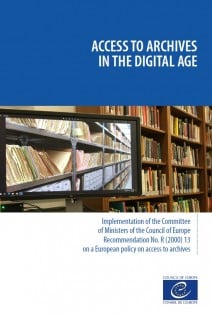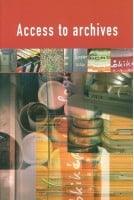Implementation of the Committee of Ministers of the Council of Europe Recommendation No. R (2000) 13 on a European policy on access to archives
Recommendation No. R (2000) 13 on a European policy on access to archives was adopted by the Committee of Ministers of the Council of Europe on 13 July 2000 on the basis that archives constitute an essential and irreplaceable element of culture. The recommendation was the first international standard in this field and it formulated several principles with a view to inspiring sound policies in the member states on access to archives, through legislation or by bringing existing legislation into line with the recommendation.
Following the adoption of the recommendation, a pan-European survey on European states’ compliance with the recommendation was initiated. The results of the survey were published by the Council of Europe in 2005, Access to archives – A handbook of guidelines for implementation of Rec No. R (2000) 13 on a European policy on access to archives.
Two decades later, a new study has explored and evaluated the situation regarding access to archives in Council of Europe member states. This publication summarises the most important results of a Europe-wide survey on the situation of access to archives in general and on the implementation of Recommendation No. R (2000) 13 in particular. It highlights current and future challenges arising from digitisation and changing user expectations, thus providing background knowledge for civil servants and decision makers, archive authorities and archivists, the scientific community and civil society organisations.
CHAPTER 1 – INTRODUCTION
1.1. Background and history
1.2. New developments
1.3. Goal of the study
CHAPTER 2 – METHODOLOGY
2.1. General approach
2.2. The target groups of the survey
2.3. Questionnaire
2.4. Field work
2.5. Response rates
2.6. Data analysis
2.7. Interviews
CHAPTER 3 – STATUS OF THE IMPLEMENTATION OF THE RECOMMENDATION
3.1. Awareness and compatibility with national legislation
3.2. Exemptions from regulation
3.3. Nationwide validity
3.4. Access as a right
3.5. Authorisation
3.6. Rules for specific user groups
3.7. Costs of access and document reproduction
3.8. General closure periods
3.9. Documents with restricted access
3.10. Finding aids
3.11. Special permission to access restricted documents
3.12. Partial access to restricted documents
3.13. Refusal of access and appeal options
3.14. Private Archives
3.15. Interim summary
CHAPTER 4 – TECHNICAL DEVELOPMENTS AND CHALLENGES
4.1. Digitisation and online services
4.2. Current and future challenges for the accessibility of archives
CHAPTER 5 – CONCLUSIONS FIGURES TABLES REFERENCES





